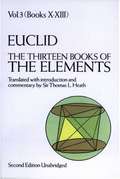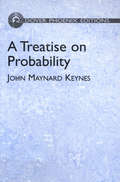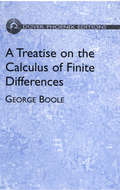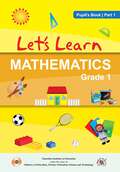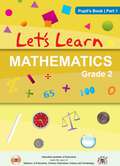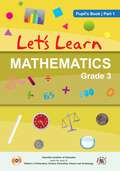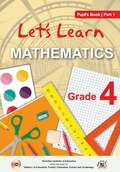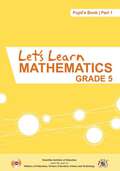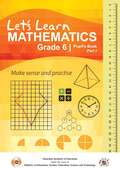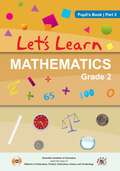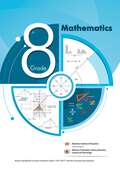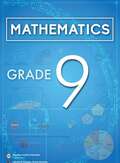- Table View
- List View
The Thirteen Books of the Elements, Vol. 3 (Dover Books on Mathematics #3)
by EuclidThis is the definitive edition of one of the very greatest classics of all time—the full Euclid, not an abridgement. Utilizing the text established by Heiberg, Sir Thomas Heath encompasses almost 2500 years of mathematical and historical study upon Euclid.This unabridged republication of the original enlarged edition contains the complete English text of all 13 books of the Elements, plus a critical apparatus which analyzes each definition, postulate, and proposition in great detail. It covers textual and linguistic matters; mathematical anayses of Euclid's ideas; classical, medieval, Renaissance, modern commentators; refutations, supports, extrapolations, reinterpretations, and historical notes, all given with extensive quotes.
A Treatise on Probability
by John Maynard KeynesWith this treatise, an insightful exploration of the probabilistic connection between philosophy and the history of science, John Maynard Keynes (1883-1946) breathed new life into studies of both disciplines. Originally published in 1921, the famous economist's most important mathematical work represented a significant contribution to the theory regarding the logical probability of propositions. Keynes effectively dismantled the classical theory of probability, launching what has since been termed the "logical-relationist" theory. In so doing, he explored the logical relationships between classifying a proposition as "highly probable" and as a "justifiable induction."A Treatise on Probability argues that probability is a matter of logic, which renders it objective: a statement involving probability relations possesses a truth value independent of opinion. Keynes demonstrates that if a hypothesis has even the smallest finite probability, it can be transformed into certainty by a sufficient number of observations. This is his attempt to overcome Humean skepticism by asserting that theoretically grounded hypotheses need only exhibit finite probability to form the basis of science and rational action. Another key idea discussed in A Treatise on Probability is that probability relations constitute only a partially ordered set in the sense that two probabilities cannot necessarily always be compared. Keynes further maintains that probability is a basic concept that cannot be reduced to other concepts.
A Treatise on the Calculus of Finite Differences
by George BooleWritten by a great English mathematician, this classic text begins with the differences of elementary functions and explores interpolation, mechanical quadrature, finite integration, and the summation of series. Several useful tests for the convergence and divergence of series are developed, as is a method for finding the limits of error in series expansions. The latter half of the book discusses difference-equations, including linear, mixed, and partial difference-equations, and concludes with applications to problems in geometry and optics. The text pays particular attention to the connection of the calculus of finite differences with the differential calculus, and more than 200 problems appear in the text (some with solutions). Unabridged republication of the classic 1872 edition.
A Treatise on the Differential Geometry of Curves and Surfaces (Dover Books on Mathematics)
by Luther Pfahler EisenhartCreated especially for graduate students, this introductory treatise on differential geometry has been a highly successful textbook for many years. Its unusually detailed and concrete approach includes a thorough explanation of the geometry of curves and surfaces, concentrating on problems that will be most helpful to students. 1909 edition.
The USSR Olympiad Problem Book: Selected Problems and Theorems of Elementary Mathematics (Dover Books on Mathematics)
by I. M. Yaglom D. O. Shklarsky N. N. ChentzovThis book contains 320 unconventional problems in algebra, arithmetic, elementary number theory, and trigonometry. Most of the problems first appeared in competitive examinations sponsored by the School Mathematical Society of the Moscow State University and the Mathematical Olympiads held in Moscow. Although most of the problems presuppose only high school mathematics, they are not easy; some are of uncommon difficulty and will challenge the ingenuity of any research mathematician. Nevertheless, many are well within the reach of motivated high school students and even advanced seventh and eighth graders.The problems are grouped into twelve separate sections. Among these are: the divisibility of integers, equations having integer solutions, evaluating sums and products, miscellaneous algebraic problems, the algebra of polynomials, complex numbers, problems of number theory, distinctive inequalities, difference sequences and sums, and more.Complete solutions to all problems are given; in many cases, alternate solutions are detailed from different points of view. Solutions to more advanced problems are given in considerable detail. Moreover, when advanced concepts are employed, they are discussed in the section preceding the problems. Useful in a variety of ways in high school and college curriculums, this challenging volume will be of particular interest to teachers dealing with gifted and advanced classes.
Vector Geometry
by Gilbert De RobinsonThis brief undergraduate-level text by a prominent Cambridge-educated mathematician explores the relationship between algebra and geometry. An elementary course in plane geometry is the sole requirement for Gilbert de B. Robinson's text, which is the result of several years of teaching and learning the most effective methods from discussions with students. Topics include lines and planes, determinants and linear equations, matrices, groups and linear transformations, and vectors and vector spaces. Additional subjects range from conics and quadrics to homogeneous coordinates and projective geometry, geometry on the sphere, and reduction of real matrices to diagonal form. Exercises appear throughout the text, with complete answers at the end.
Vector Methods: Applied to Differential Geometry, Mechanics, and Potential Theory
by D. E. RutherfordDesigned to familiarize undergraduates with the methods of vector algebra and vector calculus, this text offers both a clear view of the abstract theory as well as a concise survey of the theory's applications to various branches of pure and applied mathematics. A chapter on differential geometry introduces readers to the study of this subject by the methods of vector algebra. The next section explores the many aspects of the theory of mechanics adaptable to the use of vectors, and a full discussion of the vector operator "nabla" proceeds to a treatment of potential theory and Laplace's equation. This includes applications to the theories of gravitation, hydrodynamics, and electricity. A brief chapter on four-dimensional vectors concludes the text.
ABC's of Science
by Charles A. OliverThis books is about alpha, beta, and gamma. These are the first three letters of the Greek alphabet. <P> <P> This alphabet was the major method of written communication in ancient times, and is of course still used today. The Greek letters are also the most commonly used symbols in science. In all branches of science, we use symbols to represent ideas and definitions. Symbols serve to simplify communication and calculations—once you get used to them, that is.
The First Six Books of the Elements of Euclid: With Notes
by John Casey EuclidThe First Six Books of the Elements of Euclid With Notes by John Casey and Euclid
Let’s Learn Mathematics Part-1 - Pupil’s Book class 1 - MIE
by Mauritius Institute of EducationThe Mathematics Pupil’s Book Part 1 for Grade 1 offers a comprehensive foundation for young learners in fundamental mathematical concepts aligned with the National Curriculum Framework. Structured around three engaging themes - Home, School, and Games - the textbook incorporates a variety of activities, such as drawing, tracing, writing, coloring, matching, sorting, and comparing objects and numbers. These activities are designed to be interactive and enjoyable, fostering a child-friendly learning environment. Clear learning objectives and outcomes are outlined for each theme and unit, accompanied by continuous assessment and profiling exercises to gauge student progress. The textbook also features an annex with a memory game to reinforce recognition of shapes, colors, and numbers. Overall, it provides a well-rounded and interactive approach to cultivating essential mathematical skills in Grade 1 students.
Let’s Learn Mathematics Part-1 - Pupil's Book class 2 - MIE
by Mauritius Institute of EducationThe Grade 2 Mathematics Workbook and Teacher’s Book align with the philosophical principles of the New Curriculum Framework (Primary) and extend the pedagogical approaches from Grade 1. Designed to facilitate a smooth transition, the materials aim to enhance pupils' understanding and enjoyment of key mathematical concepts. Concepts are introduced sequentially through engaging stories, connecting them to real-life contexts, with an emphasis on interdisciplinary links, life skills, and ICT integration. Child-friendly presentation and progressive activities aid comprehension, while continuous assessment and profiling support educators in monitoring pupil progress. The role of educators as facilitators is underscored, encouraging them to leverage the 'Note to Teacher' for effective conceptual understanding. The Mathematics Panel anticipates that these curriculum materials will instill enjoyment and foster a deeper interest in the study of Mathematics among pupils.
Let’s Learn Mathematics Part-1 - Pupil’s Book class 3 - MIE
by Mauritius Institute of EducationThe Grade 3 Mathematics Pupil’s Book Part 1 offers a comprehensive exploration of key mathematical concepts essential for third-grade students. It covers Geometry, introducing shapes, sides, vertices, patterns, tessellation, and activities integrating ICT tools like Ms Paint. Additionally, it delves into Graphs, teaching how to understand and create pictograms, count shapes, and interpret data using ICT tools. The book also focuses on Numbers, from 0 to 1000, emphasizing place value, number sequences, and exercises involving the abacus and number lines. Furthermore, it addresses Addition techniques, including adding numbers with and without carrying, solving word problems, and utilizing ICT for practice. Mass concepts, such as comparing weights and practical activities to grasp kilograms, are also covered. Emphasizing technology in learning, the book incorporates continuous assessment and profiling sections to monitor student progress effectively.
Let's Learn Mathematics Part-1 - Pupil's Book class 4 - MIE
by Mauritius Institute of EducationThe Mathematics Grade 4 Pupil's Book Part 1 for Mauritius encompasses a comprehensive curriculum divided into eight units. It begins with foundational skills in numeration, addition, subtraction, multiplication, and division, progressing to more advanced concepts like patterns, even and odd numbers, and fractions. The foreword and preface introduce the book's objectives, layout, and contributors, while the table of contents aids navigation. Learning objectives emphasize key skills pupils should master, including numerical operations and problem-solving. Each unit features subtopics, examples, exercises, activities, an IT corner, and continuous assessment. From numeration and notation to fractions, the textbook systematically guides students through the mathematical landscape. A final revision sheet consolidates learning, offering a thorough review with diverse question types and answers, ensuring a holistic grasp of Grade 4 mathematics.
Let's Learn Mathematics Part-1 - Pupil's Book class 5 - MIE
by Mauritius Institute of EducationThe "MATHEMATICS Grade 5 Pupil’s Book Part 1" is a comprehensive textbook crafted by a panel of mathematics experts from the Mauritius Institute of Education and the Ministry of Education and Human Resources, Tertiary Education and Scientific Research. Designed for Grade 5 students in Mauritius, the book covers essential aspects of the mathematics curriculum, including numeration, notation, geometry, fractions, and powers. With a vibrant and visually appealing layout, the book features clear learning objectives, engaging activities, illustrative examples, and diverse exercises for practice. Aligned with the national curriculum framework, it incorporates continuous assessments to gauge understanding. The book employs a friendly tone to inspire students, providing encouragement, tips, and hints, and includes questions, puzzles, and games to foster curiosity. Intended for students, teachers, and parents, this resource aims to cultivate mathematical proficiency, skills, confidence, appreciation, and interest in young learners.
Let's Learn Mathematics Part-1 - Pupil's Book class 6 - MIE
by Mauritius Institute of EducationGrade 6 part 1 mathematics textbook follows the National Curriculum Framework, encompassing units on shapes, numeration, fractions, decimals, and problem-solving techniques. The curriculum introduces students to 2-D and 3-D shapes, emphasizing properties, classification, and drawing techniques. Numeration and place value cover reading and writing large numbers, using tools like arrays and abacus. The text explores division with remainders, methods for comparing quantities, and the concepts of fractions and decimals, detailing addition, subtraction, multiplication, and division operations. Problem-solving strategies like thinking blocks and drawing diagrams are introduced with examples spanning various real-world scenarios. The book includes continuous assessments and challenging problems across multiple mathematical domains, fostering problem-solving skills. Motivational quotes from mathematicians and scientists aim to inspire students, while thorough references provide additional resources. Answers are provided with explanations, utilizing LaTeX for mathematical expressions. This comprehensive textbook aims to engage and empower Grade 6 pupils in their mathematical learning journey.
Let’s Learn Mathematics Part-2 - Pupil’s Book class 1 - MIE
by Mauritius Institute of EducationThe Mathematics Pupil’s Book Part 2 for Grade 1 is a comprehensive resource designed to cultivate fundamental mathematical concepts and skills in young learners. Covering areas such as numbers, shapes, addition, ordinal numbers, length, mass, time, and money, the textbook engages students with thematic units like "Food," "Transport," and "Animals." Each unit creatively integrates mathematical principles with real-world examples, such as fruits and vegetables, vehicles, and animals, making the learning experience relatable and enjoyable. In addition to these thematic units, the textbook provides valuable sections including Learning Objectives, Acknowledgements, Table of Contents, Profiling, and IT Pack, offering insights into the textbook's aims, authors, structure, assessment, and online resources. This holistic approach ensures a well-rounded learning experience, fostering the development of essential mathematical skills in Grade 1 students.
Let’s Learn Mathematics Part-2 - Pupil's Book class 2 - MIE
by Mauritius Institute of EducationThe Mathematics Grade 6 Pupil’s Book Part 2, designed for students in Mauritius, is a comprehensive textbook developed by the Mauritius Institute of Education and the Ministry of Education and Human Resources. The textbook comprises of units covering diverse mathematical topics like patterns, sequences, powers, time, area, percentages, averages, ratio, proportion, angles, charts, coordinates, line graphs, volume, speed, and problem-solving. Each unit begins with clear learning objectives and concludes with activities to assess students' understanding and skills. The content is reinforced with examples, diagrams, tables, and pictograms to illustrate concepts and methods. Additionally, appendices at the end provide valuable templates for creating 3-D cubes and cuboids, along with examples of shapes and their names. This well-structured textbook aims to enhance students' mathematical proficiency through engaging content and practical exercises.
Let’s Learn Mathematics Part-2 - Pupil’s Book class 3 - MIE
by Mauritius Institute of EducationThe Grade 3 Mathematics Pupil’s Book Part 2 delves into fundamental concepts such as capacity, ordinal numbers, Roman numerals, multiplication, and more. Designed to enhance arithmetic skills and mental calculations, it also focuses on fractions and measurement. Through engaging activities, students explore concepts like measuring length, solving word problems, and grasping the significance of units. With clear learning objectives centered around arithmetic operations and practical application, this book aims to foster a comprehensive understanding of mathematical concepts essential for the Grade 3 curriculum.
Let's Learn Mathematics Part-2 - Pupil's Book class 4 - MIE
by Mauritius Institute of EducationThe grade 4 mathematics textbook, part 2 of a series, delves into fundamental mathematical concepts with a focus on practical applications for fourth-grade pupils. Covering lines, angles, 2-D and 3-D shapes, time, length, capacity, mass, and graphs, the curriculum emphasizes hands-on learning. Students learn to draw and compare lines, create and measure angles using an angle maker, and explore the properties of 2-D and 3-D shapes. The textbook introduces time-telling skills using analog and digital clocks, and addresses the measurement of length, capacity, and mass with real-world examples. Additionally, it provides a foundation for data interpretation through the representation and analysis of graphs using pictograms and bar charts. This comprehensive approach aims to foster a holistic understanding of mathematical principles while promoting practical problem-solving skills.
Let's Learn Mathematics Part-2 - Pupil's Book class 5 - MIE
by Mauritius Institute of EducationThis grade 5 mathematics textbook comprises four comprehensive units designed to enhance pupils' mathematical proficiency. Unit 1, "Numbers," delves into concepts such as average, direct proportion, ratio, and fractions, offering clear definitions, examples, and engaging activities. Unit 2, "Measure," explores diverse measurement topics, including length, perimeter, area, capacity, mass, money, and time, emphasizing practical applications through exercises and word problems. Unit 3, "Graphs," focuses on pictograms and bar charts, guiding pupils in interpreting and utilizing graphs for data representation. The final unit, "Continuous Assessment," evaluates students through multiple-choice and short-answer questions, ensuring a thorough understanding of the material. Throughout the textbook, each unit features valuable tips and hints to facilitate comprehension and practical application of mathematical principles.
Let's Learn Mathematics Part-2 - Pupil's Book class 6 - MIE
by Mauritius Institute of EducationThe textbook, "MATHEMATICS Grade 6 Pupil’s Book Part 2," authored by Professor Vassen NAËCK and a team of mathematics experts from the Mauritius Institute of Education and the Ministry of Education, serves as a comprehensive guide for sixth-grade students. Covering essential mathematical concepts, it spans topics such as numbers, measure, geometry, charts, and problem-solving. Highlighting key units, the textbook explores Patterns and Sequences (Unit 16), Powers (Unit 17), and Time - Calendar (Unit 18). These units provide in-depth explanations, examples, and exercises, offering students a thorough understanding of mathematical principles. The textbook's well-structured content, consisting of units with diverse subtopics, ensures a comprehensive approach to sixth-grade mathematics education. Furthermore, the appendices provide practical templates for constructing 3-D cubes and cuboids, enhancing the hands-on learning experience. Overall, the textbook serves as a valuable resource, fostering a holistic and engaging learning environment for students.
Mathematics class 7 - MIE
by Mauritius Institute of EducationThe Grade 7 Mathematics textbook, authored by Professor Vassen Naëck and a team from the Mauritius Institute of Education, serves as a vital resource in aligning with the National Curriculum Framework, guiding students through a seamless transition from Grade 6 to secondary education. Its comprehensive content spans Numbers, Algebra, Measures, Geometry, and Probability + Statistics, emphasizing problem-solving and real-world applications. Utilizing a pedagogical approach that prioritizes sense-making and reasoning, the textbook integrates digital tools like GeoGebra to deepen understanding. With various icons highlighting activities, exercises, and notes, the text promotes interactive and engaging learning experiences, fostering a deeper comprehension of mathematical concepts.
Mathematics class 8 - MIE
by Mauritius Institute of EducationThe Grade 8 Mathematics textbook by the Mauritius Institute of Education, published in 2021, presents a comprehensive curriculum aligned with the National Curriculum Framework. It covers diverse mathematical topics, including number sequences, indices, rate and proportion, coordinates, algebra, and geometry. Each chapter begins with clear learning objectives and provides ample exercises, examples, and summaries to aid comprehension. Emphasizing real-life applications, the textbook illustrates concepts such as Fibonacci sequences in nature and architectural scales, fostering contextual learning. The educational content is meticulously crafted to enhance learners' cognitive skills through practical activities and contextualized problem-solving. This textbook serves as an invaluable resource for Grade 8 students, facilitating their mathematical understanding and application in various real-world scenarios.
Mathematics class 9 - MIE
by Mauritius Institute of EducationPublished by the Mauritius Institute of Education in 2021, the Grade 9 mathematics textbook offers a comprehensive alignment with the National Curriculum Framework, prioritizing the enhancement of learners' cognitive abilities through contextualized materials. Covering a range of topics including indices, binomial expressions, quadratics, and algebraic manipulation, the textbook incorporates exercises and continuous assessments to reinforce learning. Rooted in Variation Theory, the pedagogical approach aims to facilitate students' discernment of key concepts within each topic, fostering procedural fluency. This collaborative effort between MIE academics and seasoned educators ensures the delivery of high-quality content that effectively meets educational objectives, providing students with a solid foundation in mathematics.
Is Behavioral Economics Doomed: The Ordinary Versus The Extraordinary
by David K. LevineIt is fashionable to criticize economic theory for focusing too much on rationality and ignoring the imperfect and emotional way in which real economic decisions are reached. All of us facing the global economic crisis wonder just how rational economic men and women can be. Behavioral economics — an effort to incorporate psychological ideas into economics — has become all the rage. <p><p> This book by well-known economist David K. Levine questions the idea that behavioral economics is the answer to economic problems. It explores the successes and failures of contemporary economics both inside and outside the laboratory. It then asks whether popular behavioral theories of psychological biases are solutions to the failures. It not only provides an overview of popular behavioral theories and their history, but also gives the reader the tools for scrutinizing them. <p> Levine’s book is essential reading for students and teachers of economic theory and anyone interested in the psychology of economics.
